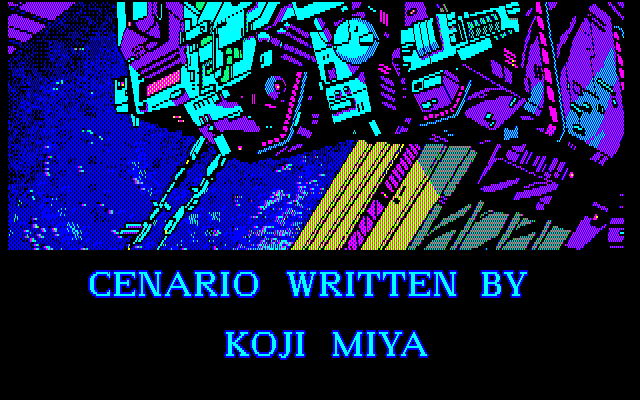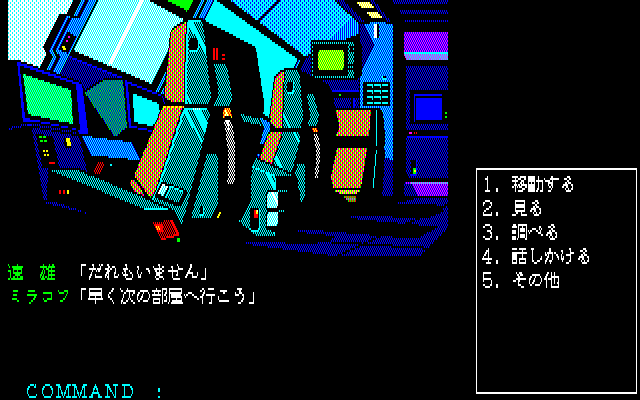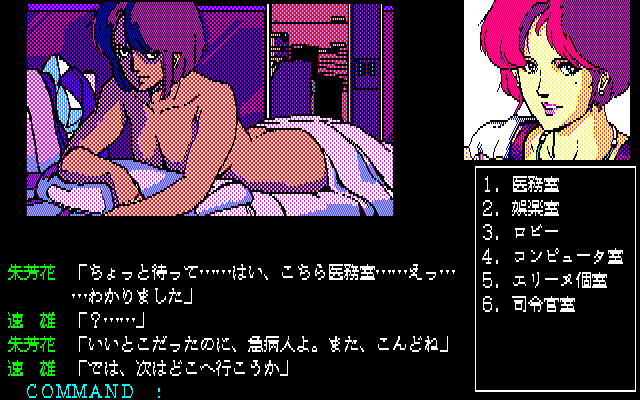Retro Replay Review
Gameplay
Jesus: Kyōfu no Bio-Monster adopts a classic Japanese adventure-game structure, putting players in the shoes of pilot Hayao Musou as they explore Space Lab Jesus and beyond. Each area is presented through a static but detailed image, paired with context-sensitive commands that allow for examination, item use, dialogue, and movement. This point-and-click approach keeps the focus on atmosphere and narrative rather than reflexes, making every decision feel deliberate and weighty.
(HEY YOU!! We hope you enjoy! We try not to run ads. So basically, this is a very expensive hobby running this site. Please consider joining us for updates, forums, and more. Network w/ us to make some cash or friends while retro gaming, and you can win some free retro games for posting. Okay, carry on 👍)
The game’s command menu evolves as you progress, unlocking new options like specialized scientific analyses and emergency protocols. Early puzzles hinge on simple item combinations—finding a sample container, locking down airlocks—while later challenges weave environmental hazards and mysterious biological readings into intricate multi-step solutions. Although some puzzles can feel obtuse without careful note-taking, hints tucked into log entries and character banter help guide resourceful players towards breakthroughs.
Interaction with your multinational crewmates adds another layer of gameplay depth. Dialogue choices won’t branch the main plot significantly but do unlock supplementary documents, lab reports, and character insights. These extras not only expand the backstory of the stranded probe Comet but also reward thorough explorers with a more complete understanding of the looming threat. Players who invest time in scanning every screen and piecing together environmental clues will be most satisfied by the densely woven mystery.
Graphics
Visually, Jesus: Kyōfu no Bio-Monster delivers a retro-futuristic aesthetic that will appeal to fans of late-80s and early-90s pixel art adventures. Lab corridors are rendered in muted grays and blues, while the blackness of space and the glowing tail of Halley’s Comet provide vivid contrast. Though the backgrounds are static, careful use of color and shading brings depth to each location, from the cramped control rooms of the Corona probe to the eerie, bio-luminescent surfaces of frozen ice fields.
Character portraits appear during key dialogues, showcasing distinctive designs for each crew member. Despite limited animation, expressive facial art conveys tension, fear, and determination effectively. Subtle visual effects—such as flickering lights in malfunctioning modules or drifting particles in zero gravity—enhance immersion and reinforce the sense that something has gone terribly wrong aboard the Comet probe.
While modern gamers accustomed to high-resolution 3D environments may find the presentation simplistic, the pixel-based style suits the game’s investigative pace perfectly. Text overlays and interface windows feel integrated into the scene rather than pasted on top, and the occasional full-screen illustration accompanying major story reveals provides a striking break from the routine exploration screens.
Story
The year is 2061, and humanity stands at the brink of a cosmic revelation. Halley’s Comet, hurtling toward Earth, may hold the key to life’s origins—and possibly to its end. Players learn that the probe Comet has gone entirely dark, and rumors of a “bio-monster” outbreak aboard inspire dread in both the crew and the player. This premise is enough to hook anyone curious about space horror and scientific thriller narratives.
As Hayao Musou, you sift through crew logs, system reports, and emergency broadcasts while coordinating with the still-functioning Corona probe. Each discovery raises more questions: what altered Comet’s environmental controls? Why did a routine gas sampling turn into a life-or-death struggle? The pacing is deliberate, gradually unveiling the sinister twist of Halley’s Comet harboring an unknown organism that mutates biological and mechanical systems alike.
The multinational cast deepens the drama, offering perspectives shaped by diverse cultural backgrounds and scientific disciplines. Moments of camaraderie over data sharing are quickly shattered by heart-pounding encounters with the unknown entity. The narrative excels at balancing scientific curiosity with primal fear, delivering a storyline that feels both cerebral and viscerally unnerving.
Overall Experience
Jesus: Kyōfu no Bio-Monster stands out as a niche but memorable adventure that will resonate with players seeking a methodical, story-driven experience. Its deliberate pacing rewards attentive exploration, and the interplay of science fiction and horror elements keeps tension high throughout the roughly six- to eight-hour runtime. Fans of classic point-and-click adventures will appreciate the throwback interface and the satisfaction of cracking complex, lore-rich puzzles.
While the static visuals and text-heavy interactions may deter those accustomed to more action-oriented gameplay, the game’s strength lies in its atmosphere and world-building. The sense of isolation aboard a failing space probe, the chilling silence of outer space, and the ever-present danger of a mutating lifeform combine to create a hauntingly immersive experience.
In sum, Jesus: Kyōfu no Bio-Monster offers an engrossing blend of mystery, science, and suspense. It may not be for everyone, but players who relish unhurried exploration, thought-provoking puzzles, and a spine-tingling narrative will find themselves captivated from lift-off to the final revelation.
 Retro Replay Retro Replay gaming reviews, news, emulation, geek stuff and more!
Retro Replay Retro Replay gaming reviews, news, emulation, geek stuff and more!









Reviews
There are no reviews yet.